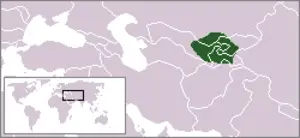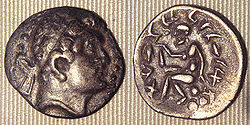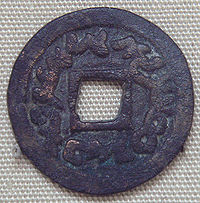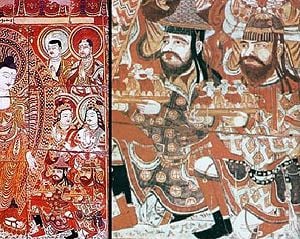Sogdiana
 Sogdiana, ca. 300 B.C.E. | |
| Languages | Sogdian language |
|---|---|
| Religions | Buddhism, Zoroastrianism |
| Capitals | Samarkand, Bukhara, Khujand, Kesh |
| Area | Between the Amu Darya and the Syr Darya |
| Existed | |
Sogdiana or Sogdia (Tajik: Суғд - Old Persian: Sughuda; Persian: سغد; Chinese: 粟特 - Sùtè) was the ancient civilization of an Iranian people and a province of the Achaemenid Persian Empire, the eighteenth in the list in the Behistun Inscription of Darius the Great (i. 16). Sogdiana is "listed" as the second 'good lands and countries' that Ahura Mazda created. This region is listed after the first, Airyana Vaeja, Land of the Aryans, in the Zoroastrian book of Vendidad, hence one can see how ancient this region is considered.[1] Sogdiana, at different periods of time, included territories around Samarkand, Bukhara, Khujand and Kesh in modern Uzbekistan.
The Sogdian states, although never politically united, were centred around their main city of Samarkand. It lay north of Bactria, east of Khwarezm, and southeast of Kangju between the Oxus (Amu Darya) and the Jaxartes (Syr Darya), embracing the fertile valley of the Zarafshan (ancient Polytimetus). Sogdian territory corresponds to the modern provinces of Samarkand and Bokhara in modern Uzbekistan as well as the Sughd province of modern Tajikistan.
History
Hellenistic period
The Sogdian Rock or Rock of Ariamazes, a fortress in Sogdiana, was captured in 327 B.C.E. by the forces of Alexander the Great, who united Sogdiana with Bactria into one satrapy. Subsequently it formed part of the Hellenistic Greco-Bactrian kingdom, founded in 248 B.C.E. by Diodotus, for about a century. Euthydemus I seems to have held the Sogdian territory, and his coins were later copied locally. Eucratides apparently recovered sovereignty on Sogdia temporarily. Finally the area was occupied by nomads when the Scythians and Yuezhis overran it around 150 B.C.E.
Contacts with China
The Sogdians occupied a key position along the ancient Silk Road, and played a major role in facilitating trade between China and Central Asia. Their contacts with China were triggered by the embassy of the Chinese explorer Zhang Qian during the reign of Wudi in the former Han Dynasty, 141-87 B.C.E. He wrote a report of his visit in Central Asia, and named the area of Sogdiana, "Kangju."
Following Zhang Qian's embassy and report, commercial Chinese relations with Central Asia and Sogdiana flourished, as many Chinese missions were sent throughout the 1st century B.C.E.: "The largest of these embassies to foreign states numbered several hundred persons, while even the smaller parties included over 100 members... In the course of one year anywhere from five to six to over ten parties would be sent out." (Shiji, trans. Burton Watson). However the Sogdian traders were then still less important in the Silk Road trade than their Southern neighbours, Indian and Bactrian.
Central Asian role
.
The Sogdians dominated the East-West trade after the 4th century CE up to the 8th century CE, with Suyab and Talas ranking among their main centres in the north. They were the main caravan merchants of Central Asia. Their commercial interests were protected by the resurgent military power of the Göktürks, whose empire has been described as "the joint enterprise of the Ashina clan and the Soghdians" [1] [2]. Their trades with some interruptions continued in 9th century. It is occurred in 10th century within the framework of the Uighur Empire, which until 840 extended all over northern Central Asia and obtained from China enormous deliveries of silk in exchange for horses. At this time caravans of Sogdians traveling to Upper Mongolia are mentioned in Chinese sources.
They played an equally important religious and cultural role. Part of the data about eastern Asia provided by Muslim geographers of the 10th century actually goes back to Sogdian data of the period 750-840 and thus shows the survival of links between east and west. However, after the end of the Uighur Empire, Sogdian trade went through a crisis. What mainly issued from Muslim Central Asia was the trade of the Samanids, which resumed the northwestern road leading to the Khazars and the Urals and the northeastern one toward the nearby Turkic tribes [2].
Language and culture
The Sogdians were noted for their tolerance of different religious beliefs. Buddhism, Manichaeism, Nestorian Christianity, and Zoroastrianism all had significant followings. Sogdians were actors in the Silk Road transmission of Buddhism, until the period of Muslim invasion in the 8th century. Much of our knowledge of the Sogdians and their language comes from the numerous religious texts that they have left behind.
The Sogdians spoke an Eastern Iranian language called Sogdian, closely related to Bactrian, another major language of the region in ancient times. Sogdian was written in a variety of scripts, all of them derived from the Aramaic alphabet.
The valley of the Zarafshan about Samarkand retained even in the Middle Ages the name of the Soghd O Samarkand. Arabic geographers reckon it as one of the four fairest districts in the world. The Yaghnobis living in the Sughd province of Tajikistan still speak a dialect of the Soghdian language.
The great majority of the Sogdian people gradually mixed with other local groups such as the Bactrians, Chorasmians, Turks and Persians, and came to speak Persian (modern Tajiks) or (after the Turkic conquest of Central Asia) Turkic Uzbek. They are among the ancestors of the modern Tajik and Uzbek people. Numerous Sogdian words can be found in modern Persian and Uzbek as a result of this admixture.
Famous Sogdians
- An Lushan was a military leader of Turkic and Sogdian origin during the Tang Dynasty in China. He rose to prominence by fighting during the Tang Frontier Wars between 741 and 755. Later, he precipitated the catastrophic An Shi Rebellion, which lasted from 755 to 763.
See also
- Shakya
- Tocharians
- Iranian languages
- Ancient Iranian peoples
Literature
- This article incorporates text from the Encyclopædia Britannica Eleventh Edition, a publication now in the public domain.
- Calum MacLeod, Bradley Mayhew “Uzbekistan. Golden Road to Samarkand”
- Archaeological Researches in Uzbekistan. 2001. Tashkent The edition is based on results of German-French-Uzbek co-expeditions in 2001 in Uzbekistan*
- Etienne de la Vaissière, Sogdian Traders. A History, Leiden : Brill, 2005. ISBN 90-04-14252-5
- Etienne de la Vaissière, Histoire des marchands sogdiens, Paris : de Boccard, 2004.
- Babadjan Ghafurov, "Tajiks," published in USSR, Russia, Tajikistan
- Vaissiere. E.D.L, "Sogdian Trade" in Encyclopedia Iranica. [2]
ReferencesISBN links support NWE through referral fees
- ↑ Wink, André. Al-Hind: The Making of the Indo-Islamic World. Brill Academic Publishers, 2002. ISBN 0391041738.
- ↑ 2.0 2.1 Sogdian Trade, Encyclopedia Iranica, (retrieved 15 June 2007) <http://www.iranica.com/newsite/articles/ot_grp7/ot_sogd_trade_20041201.html>
External links
- http://www.iranianlanguages.com
- http://www.geocities.com/interlinguae/sogdian.html
- http://www.livius.org/x/xerxes/xerxes_ii.html (Xerxes II of Persia and Sogdianus)
| ||||||||||
Credits
New World Encyclopedia writers and editors rewrote and completed the Wikipedia article in accordance with New World Encyclopedia standards. This article abides by terms of the Creative Commons CC-by-sa 3.0 License (CC-by-sa), which may be used and disseminated with proper attribution. Credit is due under the terms of this license that can reference both the New World Encyclopedia contributors and the selfless volunteer contributors of the Wikimedia Foundation. To cite this article click here for a list of acceptable citing formats.The history of earlier contributions by wikipedians is accessible to researchers here:
The history of this article since it was imported to New World Encyclopedia:
Note: Some restrictions may apply to use of individual images which are separately licensed.






